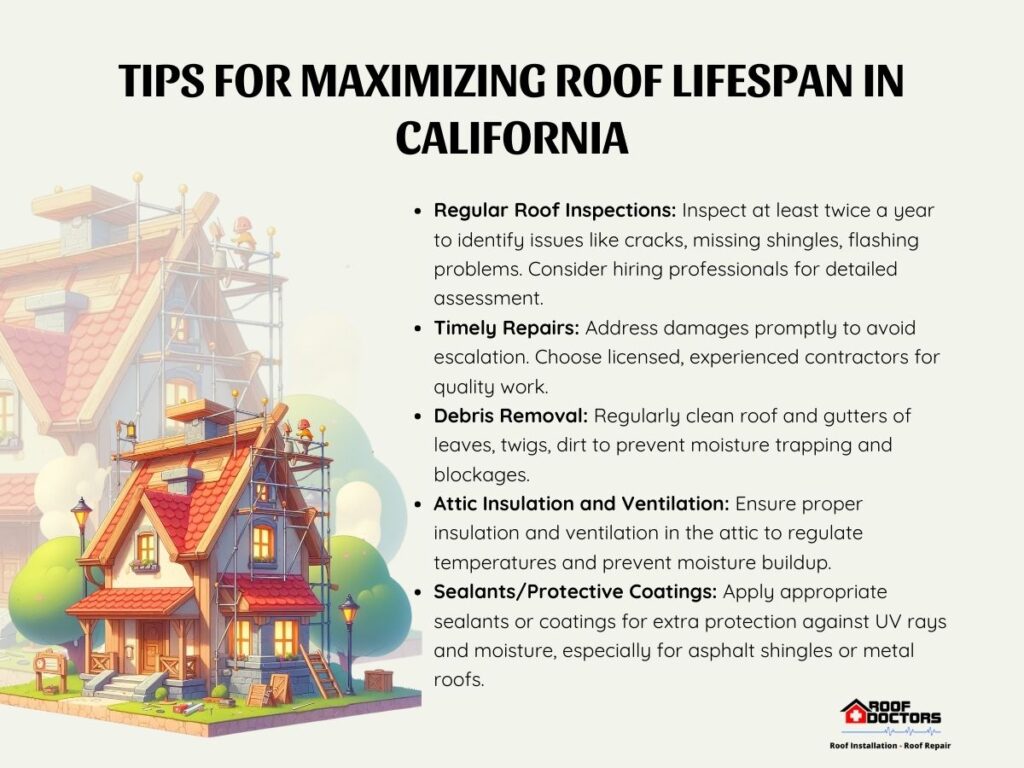Northern California’s climate, with its unique combination of sunny days, coastal fog, and occasional heavy rains, presents a distinctive challenge for the longevity of roofing materials. What are some of the effects of Northern California’s Climate on roof lifespan.
The region’s diverse weather patterns can have profound effects on the lifespan of roofs, influencing everything from material selection to maintenance practices. Understanding these impacts is crucial for homeowners and construction professionals alike.
In this blog, we’ll explore how Northern California’s climate specifically affects roof lifespan. We’ll examine factors at play and provide insights into choosing and maintaining roofing materials that can withstand the area’s distinctive weather conditions, ensuring durability and aesthetic appeal.
California’s Climate and Its Impact on Roofs
California’s diverse climate, especially in the northern regions, poses unique challenges for roofing materials. From the warm, sunny days to the moist coastal fog and the occasional heavy rainfalls, these environmental conditions significantly impact the longevity and performance of roofs.
In this section, we’ll delve into the various weather patterns of Northern California and their effects on roofing, exploring the implications of heat, humidity, salt, UV rays, and extreme weather conditions.
| Climate Factor | Effects on Roofs | Mitigation Strategies |
| Heat and UV Rays | Degradation of materialsBrittlenessLoss of granules in asphalt shinglesWarping or cracking in woodDiscoloration. | Use UV-resistant materialsReflective coatingsRegular maintenance with protective sealants. |
| Coastal Climate (Humidity and Salt) | Corrosion in metal componentsGrowth of mold and mildew on wood and asphaltGeneral deterioration. | Choose materials resistant to humidity and salt corrosionRegular cleaning Inspections |
| Extreme Weather (Droughts, Hurricanes, High Winds) | Cracking and brittleness during droughtsPhysical damage like tearing or dislodging during hurricanes and high winds | Select materials rated for high wind resistanceEnsure proper fasteningRegular inspections. |
Impact of Heat and UV Rays on Roofing Materials
In Northern California, the prevalence of sunny days contributes to substantial exposure of roofs to UV radiation and high temperatures. This consistent exposure can lead to the degradation of roofing materials over time.
Asphalt shingles, for example, can become brittle and lose their granules, while wood shakes may warp or crack under prolonged heat. UV rays, in particular, cause discoloration and weakening of materials, reducing the aesthetic appeal and structural integrity of roofs.
To combat these effects, selecting materials with UV-resistant properties is vital. Metal roofing or tiles with reflective coatings are excellent choices, as they deflect sunlight and reduce heat absorption. Additionally, regular maintenance, such as applying protective sealants, can prolong the life of the roof.
Coastal Climate
The coastal regions of Northern California are known for their high humidity and salt-laden air. This environment can be harsh on roofing materials, especially those not designed for such conditions.
Salt air can corrode metal components, while humidity can promote the growth of mold and mildew, particularly on wood and asphalt surfaces.
For homes in these areas, it is essential to choose materials that can withstand humidity and salt corrosion. Metal roofs with specialized coatings, slate, or treated wood are preferable. Regular cleaning and inspections can also mitigate these issues, ensuring the longevity of the roof.
Extreme Weather Conditions
Northern California, while known for its mild climate, is not immune to extreme weather events such as droughts, hurricanes, and high winds. Drought conditions can lead to cracking and brittleness in certain materials, while hurricanes and high winds pose a risk of physical damage, such as tearing or dislodging of roofing components.
To ensure roofs can withstand these conditions, choosing materials rated for high wind resistance is crucial. Additionally, regular inspections and maintenance, such as ensuring proper fastening of shingles or tiles, can prevent wind uplift and damage during severe weather events.
Roofing Materials and Their Lifespan in California
In the diverse climate of California, choosing the right roofing material is crucial for both longevity and performance. Popular options like asphalt shingles, metal roofing, and tile roofing each offer unique benefits and challenges.
This segment focuses on these materials, their lifespans, and how they fare in California’s climate, alongside an analysis of their pros and cons in terms of durability and cost.

Asphalt Shingles
Asphalt shingles are a common choice in California due to their cost-effectiveness and versatility. Typically, they have a lifespan of 15-30 years, but this can be shorter in regions with intense sunlight and heat, which can cause them to deteriorate faster.
Pros and Cons
- Pros: The main advantage of asphalt shingles is their affordability and a wide range of styles and colors. They are also relatively easy to install and repair.
- Cons: On the downside, they are less durable than other materials and can be prone to damage from high winds and extreme weather. They also offer minimal insulation compared to other roofing options.
Metal Roofing
Metal roofing is an excellent option for California’s varied climate, with a lifespan of 40-70 years. It withstands heat and UV rays effectively and is also resistant to high winds and heavy rains, making it a durable choice.
Pros and Cons
- Pros: Metal roofing is highly durable and requires minimal maintenance. It’s also energy-efficient, reflecting sunlight and helping to reduce cooling costs. Additionally, it’s environmentally friendly, often made from recycled materials, and fully recyclable at the end of its life.
- Cons: The initial cost of metal roofing can be higher than other materials. It can also be noisier during rain or hail unless additional insulation is used.
Tile Roofing
Tile roofing, whether clay, concrete, or slate, is known for its exceptional longevity, with lifespans often exceeding 50 years. Tiles are highly resistant to the damages caused by California’s sun and heat and are ideal for coastal areas due to their resistance to salt air.
Pros and Cons
- Pros: Tiles offer a classic aesthetic and are extremely durable. They are fireproof and offer excellent insulation properties, which can help regulate indoor temperatures.
- Cons: The major drawbacks include a higher cost and the need for a reinforced roof structure due to its weight. They can also be fragile and may crack underfoot during maintenance.
Tips for Maximizing Roof Lifespan in California
Maintaining the longevity of a roof in California, with its unique climate, requires more than just choosing the right material. Homeowners need to be proactive in their roof maintenance to ensure they get the most out of their investment.
This guide will delve into practical tips for maintaining roofs, emphasizing the importance of regular inspections, timely repairs, and debris removal, all aimed at maximizing the lifespan of your roof.

Regular Roof Inspections
One of the most effective ways to prolong the life of your roof is through regular inspections. Ideally, roofs should be inspected at least twice a year, typically in the spring and fall.
These inspections can identify potential issues like cracks, loose or missing shingles, or problems with flashing before they escalate. While some homeowners may feel comfortable conducting basic inspections themselves, it’s often beneficial to hire a professional.
Roofing experts can spot subtler signs of wear and damage that untrained eyes might miss. Plus, they can provide advice on necessary repairs and maintenance specific to your roof’s material and age.
Timely Repairs
Ignoring minor issues can lead to significant, costly problems down the line. For instance, a small leak can eventually lead to water damage, mold growth, or even structural issues.
Promptly addressing any damages not only preserves the roof’s integrity but also prevents additional repair costs. When repairs are needed, choosing the right contractor is crucial.
Look for licensed, experienced professionals with good reviews and a track record of quality work. Properly executed repairs can dramatically extend the life of your roof.
Debris Removal
Debris, like leaves, twigs, and dirt, can accumulate on your roof, especially in areas with many trees. This accumulation can trap moisture, leading to rot or mold, and can block gutters, causing water to pool on the roof.
Regular cleaning of your roof and gutters can prevent these issues. For safety and efficiency, consider hiring professionals for this task, especially for hard-to-reach or steep roofs.
Additional Tips for Roof Maintenance
- Attic insulation and Ventilation: Proper attic insulation and ventilation play a critical role in extending the life of your roof by regulating temperatures and preventing moisture buildup.
- Sealants or Protective Coatings: Applying sealants or protective coatings can offer an extra layer of protection, especially for certain materials like asphalt shingles or metal roofs, safeguarding against elements like UV rays and moisture.
How Long Does a Roof Last in California?
We’ve discussed the importance of regular maintenance, timely repairs, and debris removal in maximizing the lifespan of your roof in California. But a question that naturally follows is, “How long can I expect my roof to last in this unique climate?“
This next segment will explore the average lifespan of different roofing materials in California’s varied environment and the factors that influence their durability.


